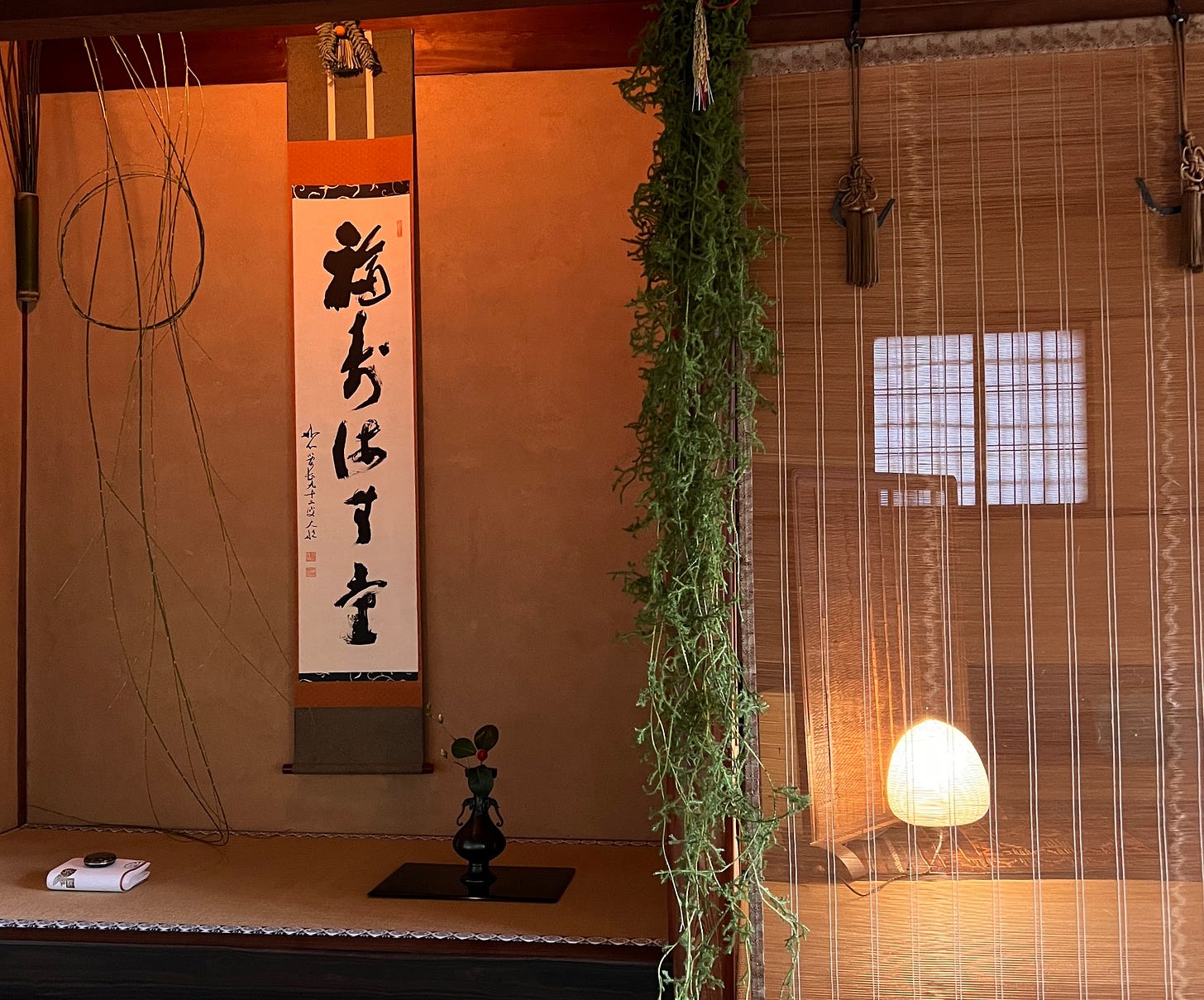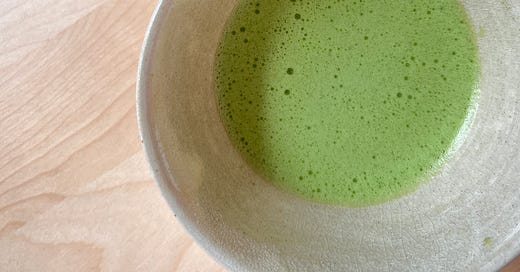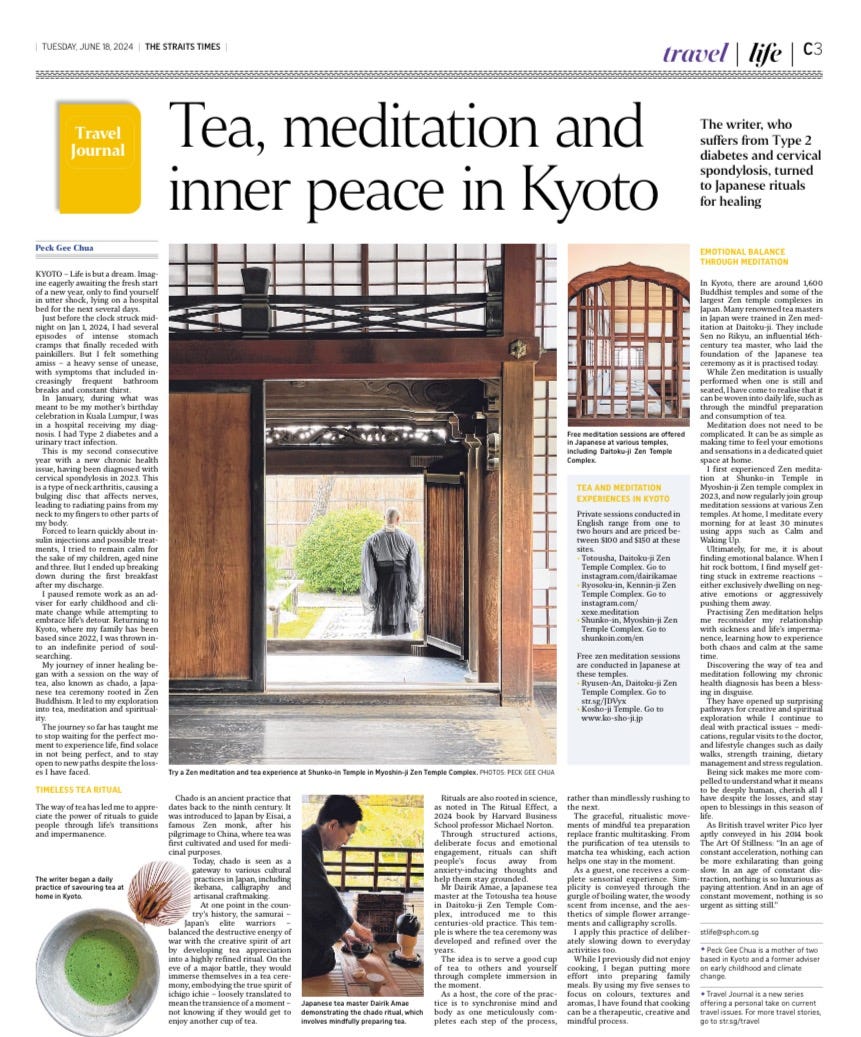Meditation and the Willow
and a Travel-Lifestyle piece published in The Straits Times, 17 June 2024
Photos by me. See Instagram | See LinkedIn | See previous posts | AboutIn the parable of the pine and the willow - The pine branch, being rigid, cracks under the weight; but the willow branch yields to the weight, and the snow drops off. Note, however, that the willow is not limp but springy.
-- Alan Watts in Tao: The Watercourse Way, 1975
We are now entering Minor Cold 小寒, 23rd of the 24 solar terms - a cyclical ancient Chinese calendar that aligns with the local climate suitable for agricultural production.
Japan’s 72 micro seasons is based on the solar terms. A further expansion of 24 major divisions or sekki into a total of 72 ko. This week (January 5-9), we transition into a new sekki-ko microseason:
小寒: 芹乃栄 - Minor Cold: Parsley flourishes
January also coincides with the comforting sights of willows in Japanese tea houses.
During the new year, musubi yanagi 結び柳 or willow with long-trailing branches tied in a loop is often used as a decoration for the first tea ceremony of the year. Visible in the tokonoma alcove display area in Japanese tea houses.
Tie-willow (looped as a circle like the sun or moon) came from the Chinese tradition to symbolize unity and the repeated return of auspicious events. A symbolism, likely originated from the Southern Song Dynasty's phrase 一阳来复, meaning "the sun returns." After the Winter Solstice, yang (warm) energy grows as yin (cool) energy ends, so is the return arrival of Springtime.

Inner work matters more than what many of us care to realize. Because we are not as in control of our circumstances as we fooled ourselves to believe in.
As an anchoring (to circle back to one’s original self), we have within our capacity to cultivate regular quiet, reflective pauses in the form of meditating, tea, writing, walking - or even just reducing phone screen time to start with so we can begin to hold space for ourselves.
Tea, Meditation and Inner Peace in Kyoto
OpEd originally published in The Straits Times, 17 June 2024 (click for link)
KYOTO – Life is but a dream. Imagine eagerly awaiting the fresh start of a new year, only to find yourself in utter shock, lying on a hospital bed for the next several days.
Just before the clock struck midnight on Jan 1, 2024, I had several episodes of intense stomach cramps that finally receded with painkillers. But I felt something amiss – a heavy sense of unease, with symptoms that included increasingly frequent bathroom breaks and constant thirst.
In January, during what was meant to be my mother’s birthday celebration in Kuala Lumpur, I was in a hospital receiving my diagnosis. I had Type 2 diabetes and a urinary tract infection.
This is my second consecutive year with a new chronic health issue, having been diagnosed with cervical spondylosis in 2023. This is a type of neck arthritis, causing a bulging disc that affects nerves, leading to radiating pains from my neck to my fingers to other parts of my body.
Forced to learn quickly about insulin injections and possible treatments, I tried to remain calm for the sake of my children, aged nine and three. But I ended up breaking down during the first breakfast after my discharge.
I paused remote work as an adviser for early childhood and climate change while attempting to embrace life’s detour. Returning to Kyoto, where my family has been based since 2022, I was thrown into an indefinite period of soul-searching.
My journey of inner healing began with a session on the way of tea, also known as chado, a Japanese tea ceremony rooted in Zen Buddhism. It led to my exploration into tea, meditation and spirituality.
The journey so far has taught me to stop waiting for the perfect moment to experience life, find solace in not being perfect, and to stay open to new paths despite the losses I have faced.
Timeless tea ritual
The way of tea has led me to appreciate the power of rituals to guide people through life’s transitions and impermanence.
Chado is an ancient practice that dates back to the ninth century. It was introduced to Japan by Eisai, a famous Zen monk, after his pilgrimage to China, where tea was first cultivated and used for medicinal purposes.
Today, chado is seen as a gateway to various cultural practices in Japan, including ikebana, calligraphy and artisanal craftmaking.
At one point in the country’s history, the samurai – Japan’s elite warriors – balanced the destructive energy of war with the creative spirit of art by developing tea appreciation into a highly refined ritual.
On the eve of a major battle, samurai would immerse themselves in the tea ceremony, embodying the true spirit of ichigo ichie – loosely translated to mean the transience of a moment – not knowing if they would get to enjoy another cup of tea.
Rituals are also rooted in science, as noted in The Ritual Effect, a 2024 book by Harvard Business School professor Michael Norton. Through structured actions, deliberate focus and emotional engagement, rituals can shift people’s focus away from anxiety-inducing thoughts and help them stay grounded.
Mr Dairik Amae, a Japanese tea master at the Totousha tea house in Daitoku-ji Zen Temple Complex, introduced me to this centuries-old practice. This temple is where the tea ceremony was developed and refined over the years.
The idea is to serve a good cup of tea to others and yourself through complete immersion in the moment.
As a host, the core of the practice is to synchronise mind and body as one meticulously completes each step of the process, rather than mindlessly rushing to the next.
The graceful, ritualistic movements of mindful tea preparation replace frantic multitasking. From the purification of tea utensils to matcha tea whisking, each action helps one stay in the moment.
As a guest, one receives a complete sensorial experience. Simplicity is conveyed through the gurgle of boiling water, the woody scent from incense, and the aesthetics of simple flower arrangements and calligraphy scrolls.
I apply this practice of deliberately slowing down to everyday activities too.
While I previously did not enjoy cooking, I began putting more effort into preparing family meals. By using my five senses to focus on colours, textures and aromas, I have found that cooking can be a therapeutic, creative and mindful process.
Emotional balance through meditation
In Kyoto, there are around 1,600 Buddhist temples and some of the largest Zen temple complexes in Japan. Many renowned tea masters in Japan were trained in Zen meditation at Daitoku-ji. They include Sen no Rikyu, an influential 16th-century tea master, who laid the foundation of the Japanese tea ceremony as it is practised today.
While Zen meditation is usually performed when one is still and seated, I have come to realise that it can be woven into daily life, such as through the mindful preparation and consumption of tea.
Meditation does not need to be complicated. It can be as simple as making time to feel your emotions and sensations in a dedicated quiet space at home.
I first experienced Zen meditation at Shunko-in Temple in Myoshin-ji Zen temple complex in 2023, and now regularly join group meditation sessions at various Zen temples. At home, I meditate every morning for at least 30 minutes using apps such as Calm and Waking Up.
Ultimately, for me, it is about finding emotional balance. When I hit rock bottom, I find myself getting stuck in extreme reactions – either exclusively dwelling on negative emotions or aggressively pushing them away.
Practising Zen meditation helps me reconsider my relationship with sickness and life’s impermanence, learning how to experience both chaos and calm at the same time.
Discovering the way of tea and meditation following my chronic health diagnosis has been a blessing in disguise.
They have opened up surprising pathways for creative and spiritual exploration while I continue to deal with practical issues – medications, regular visits to the doctor, and lifestyle changes such as daily walks, strength training, dietary management and stress regulation.
Being sick makes me more compelled to understand what it means to be deeply human, cherish all I have despite the losses, and stay open to blessings in this season of life.
As British travel writer Pico Iyer aptly conveyed in his 2014 book The Art Of Stillness: “In an age of constant acceleration, nothing can be more exhilarating than going slow. In an age of constant distraction, nothing is so luxurious as paying attention. And in an age of constant movement, nothing is so urgent as sitting still.”
Recommended tea and meditation experiences in Kyoto
Private sessions conducted in English range from one to two hours and are priced between SGD $100 and $150 at these sites.
Totousha, Daitoku-ji Zen Temple Complex. Go to www.instagram.com/dairikamae
Ryosoku-in, Kennin-ji Zen Temple Complex. Go to www.instagram.com/xexe.meditation
Shunko-in, Myoshin-ji Zen Temple Complex. Go to shunkoin.com/en
Free zen meditation sessions are conducted in Japanese at the following temples.
Ryusen-An, Daitoku-ji Zen Temple Complex. Go to str.sg/JDVyx
Kosho-ji Temple. Go to www.ko-sho-ji.jp
Photos by me. See Instagram | See LinkedIn | See previous posts | About






Beautifully written and an important message!! Tea rituals, meditations, and all mindful movements bring us to a restorative process toward unity of the mind, body, and soul, toward oneness with the flowing of Tao.
Thank you for this beautiful post ❤️